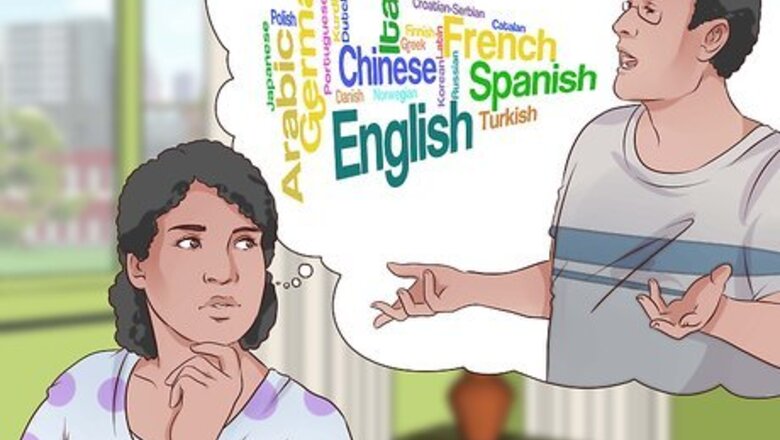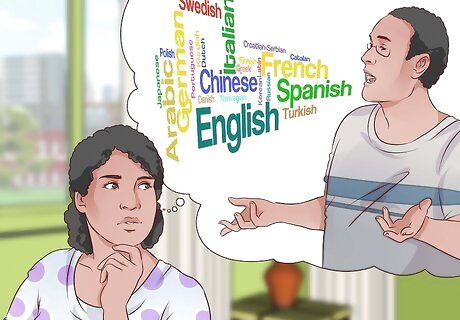
views
Building “Communicative Competence”

Consider roadblocks to adult language acquisition. It is well-established that young children are, on average, more adept at acquiring second (and beyond) languages than older teens and adults. The reasons for this, however, are not as clear. Small children tend to excel at picking up spoken languages through simple exposure to them, and some theorize that this skill is lost around the ages of 12-14 as the brain reallocates its precious resources to other, more important areas. Essentially, you are likely to have learned to communicate by then, and thus no longer need to expend substantial brain power toward that ability. Whether or not changes in the brain make language acquisition more challenging for adults, it is certain that adults tend to be busier, more stressed, and less singularly focused on picking up the language. Adults have also picked up a lifetime of assumptions, conventions, perspectives, biases, and habits, all experienced via the native language, that can make developing “communicative competence” in a second language (with its own cultural “baggage”) a more arduous task.

Assess and assist learner motivation. With any desired skill, talent, or ability, having a clear goal in mind makes the process of acquiring said competency more manageable. The same holds true for language acquisition. As a teacher, it may benefit your adult students if you help them define a clear, and ideally short-term, goal for why they want to learn a particular foreign language. Instead of promoting language-learning as beneficial in and of itself (even if it is), help them focus on their desire to connect more deeply with a grandparent or be prepared for a long-awaited trip abroad. As you help students find their motivation, feed it through targeted tasks. For instance, offer a project that involves interviewing the grandparent in his/her native (and the student’s second) language. Be aware, however, that motivation will vary in intensity class-to-class, so be prepared to take advantage of high points and offer encouragement during lower ones.

Facilitate student interaction. While you have an essential role as the teacher, the students in the class can also be critical to each other’s ability to learn a new language. Learner-to-learner interaction tends to help both parties “notice the gap” between their communication in the language and the proper form. Offering learner-to-learner tasks, such as having one student describe a picture in the foreign language to another, who must draw it, can not only be fun but helpful in enabling students to work through gaps in their comprehension. While such tasks need not replace more traditional methods of teaching vocabulary and grammar, this more indirect method of teaching the “nuts and bolts” of a new language does seem to be at least as effective at instilling them in the long run.

Build vocabulary directly and “incidentally.” It is estimated that an adult needs to understand about 3,000 word families (think, thought, and thoughtful are in one word family, for instance) to be able to understand a foreign language from context. Traditional vocabulary-building methods, like memorization, drills, and tables, can still be utilized in the classroom with success. However, simply encouraging students to read level-appropriate and interesting passages, both in class and at home, can be an effective strategy. This is especially true when the readings are combined with vocabulary-building activities. Games like Bingo, Password, and Concentration can facilitate “active meaning negotiation,” where task-oriented problem solving helps build an “incidental vocabulary” — almost, in essence, picking up new words without realizing it.

Be flexible. There are as many ideal ways to learn a new language as there are people wanting to do it. Some even say that foreign languages cannot be taught, but only learned, implying that each learner’s unique motivations and skills must be prioritized. Each time you teach a new student or new class, then, your methods will likely need to adjust in order to have the most impact. Be flexible and willing to work with your adult learners, while drawing from a range of theories, strategies, and practical advice.
Becoming Familiar With Theoretical Approaches

Compare classic and modern approaches. Whether you learned a second language by drills, flashcards, and rote repetition, or by visiting a foreign country for the summer, there is likely a language theory that matches your method. Familiarity with the bases of such approaches will help you formulate your teaching strategy for adults. From the time of ancient Greece to well into the last century, new languages were almost invariably taught by what is often called the “audio-lingual method.” If your high school French class involved a lot of rote learning, repetition, oral and written testing, emphases on grammar and translation, and constant correction by your teacher, you’re already familiar with this method. In the last half-century or so, a more (so-called) “natural approach” has become predominant. It tries to replicate the childhood process of acquiring a language through immersion, play and tasks, constant usage in a low-pressure environment, and indirect emphases on grammar and vocabulary.

See the pros and possible cons of newer views. Modern “natural” or “immersion” methods encourage leaners to jump right in to the foreign language without the drudgery of vocabulary lists, grammar lessons, and constant repetition. Therefore, they are often a more appealing prospect to harried, hurried adult learners. Such task-based methods are based on the premise that students will naturally “work out” vocabulary and grammar as they interact with the language (and the other students). The struggle to do so, essentially, is part of the learning process. Critics, however, say that this leaves too much vital material for the student to address on his or her own, and that the teacher’s guiding hand in areas like grammar is vital, even if it can sometimes be less than enthralling.

Don’t ignore traditional methods. Despite the reputation they’ve assumed as “boring,” “sterile,” and “outdated,” there is a reason why classic approaches were used almost exclusively for thousands of years. Even in the modern world, they can still have a place in the language classroom. The “audio-lingual” emphasis on habit formation, mimicry, memorization, and repetition can provide a clearer sense of the goals, processes, and achievements for some students. Likewise, a focus on grammar and translation, guided in the first language, can build essential skills that some adult learners may be keen to acquire. That said, for many adults, traditional methods will feel too much like being back in school as children, and can dissuade them from continuing the process with enthusiasm. This is why variety and flexibility in your teaching methods are essential.

Find the right balance. For all the value in understanding theories, learning happens in practice — and usually, through practice. Simply put, teaching an adult a foreign language requires not only your mastery of the language as a teacher, but also a clear understanding of your student’s background, motivation, goals, learning style, and needs. Holding fast to traditional methods simply because they have been in use for centuries is usually not the answer, nor is tossing all the old ways aside for the new vogue in language education. It is up to you, the teacher, to determine the mix that will work best for your classroom and your student(s).
Trying a Variety of Classroom Activities

Let the adults be kids. Learning a new language can be a stressful experience for many adults, and can make them feel like children struggling to pick up something new. Build on the positives of this perspective by enabling your students to have some fun with it. Most adults like to reminisce about their own childhood, or that of their growing / grown children. Let them pick a favorite kids' book from one of those times that is available in the foreign language, and read it together in class. It will seem familiar but new, and fun but challenging. Listen to songs, even sing songs together in class. Use familiar nursery rhymes and lullabyes in the foreign language, along with songs distinct to that language / culture.

Help students help one another. Most adults will be sympathetic to the experiences of the other students in the class, and want to help each other succeed. And, according to the notions of task-based learning discussed in this article, having students learn from each other's successes and mistakes is vital to adult language development. One good paired activity is the aforementioned "information gap" game of having one student describe a picture in the foreign language to another, who must draw it. A similar option is having students do a variation of the old "pass a secret down the line" game, except having them alternate the language in which the sentence is whispered -- (essentially translating back and forth down the line). Even simply encouraging your students to listen to each other carefully as they attempt to solve problems and answer questions can be quite useful. Hearing others struggle and succeed provides both consolation and challenge. Each student will also naturally "notice the gap" between the response given, how they would have responded, and/or the correct response, thereby helping to build confidence and competence.

Offer goals and rewards. Unlike many child students, adult learners usually have a specific goal in mind for wanting to learn a foreign language. Crafting activities that support this goal, and offering related goals and rewards along the way can fuel motivation and a sense of achievement. If your adult student hopes to land in a foreign country and be able to "jump right in," consider having them watch episodes of a program in that language (without subtitles!), and attempt to summarize what they can from full-speed conversations in the foreign tongue. Set up a pretend restaurant, for instance, in the classroom. Offer simple prizes for the student(s) who do best in ordering lunch. Adults like to be rewarded for small achievements just as much as children.

Don't skip the work. No, the adult classroom, just like the child one, cannot be all fun and games. Most adults will want it to be a fun experience, but in the end, learning the language is the goal. Some of the traditional methods that have at least partly fallen out of favor may be of more value to adult learners, especially those who are self-motivated to learn the language. They will be more willing to copy down verb tables and go through flash-card drills. Speaking of copying down information, encouraging your students to write down information longhand may be beneficial. (It will also probably be easier to convince adults to do this than their tech-savvy kids.) Research indicates that handwriting information aids memorization more than typing, as it requires more active participation in the process.



















Comments
0 comment